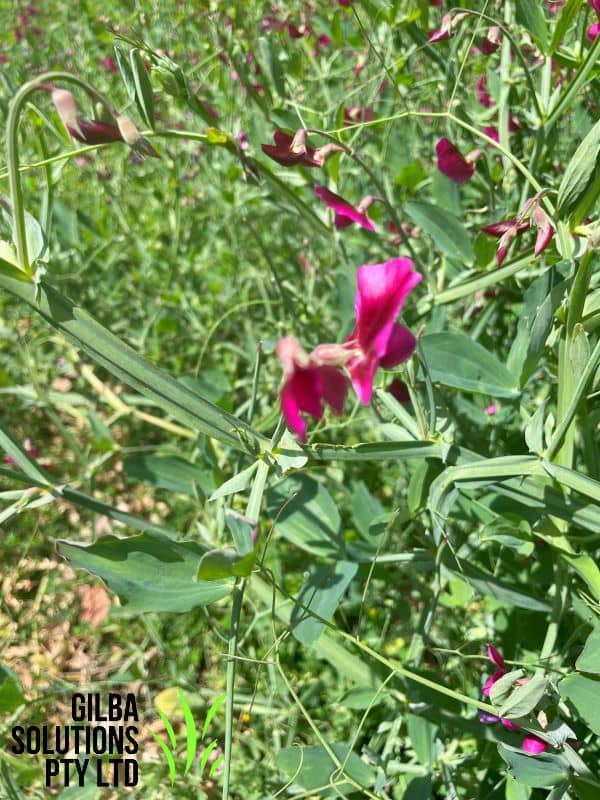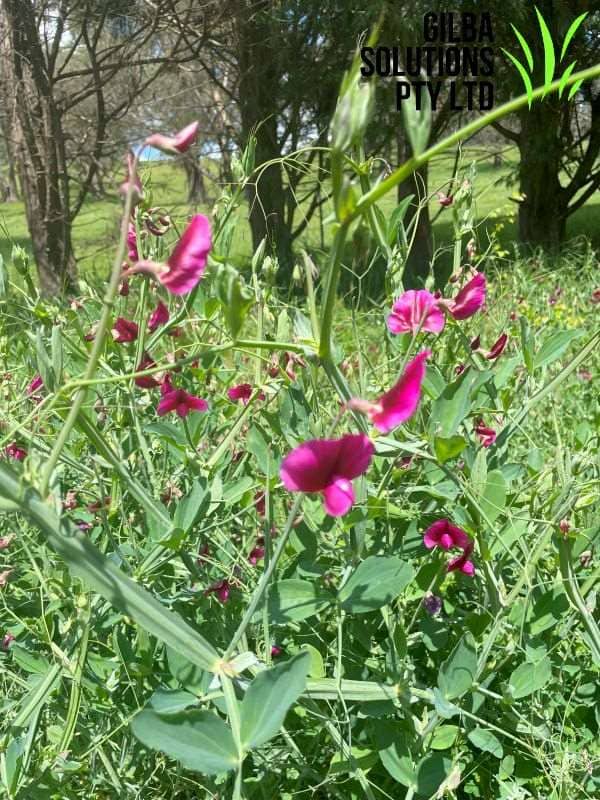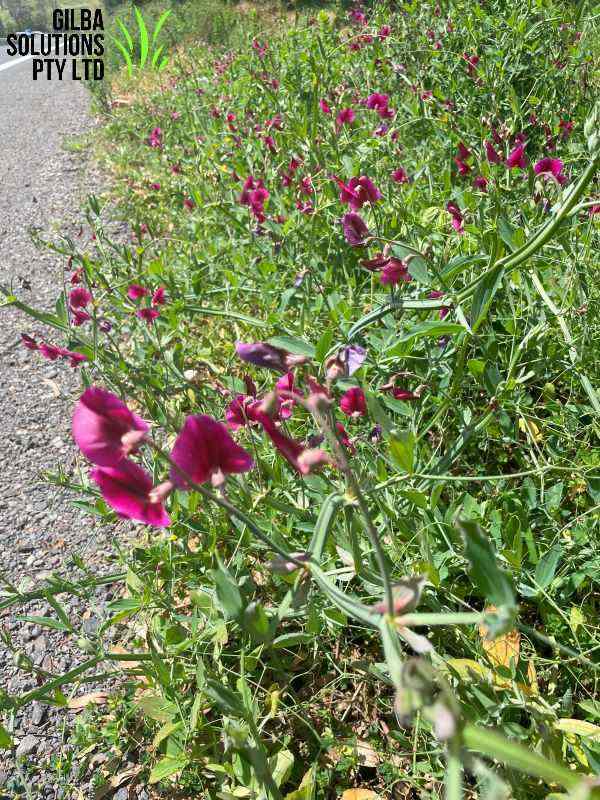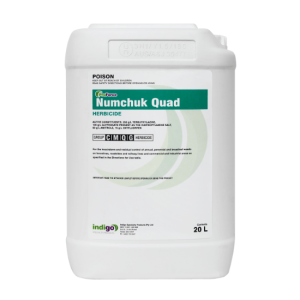Tangier Pea (Lathyrus tingitanus) Weed Identification & Control Guide – Australia.
Tangier Pea (Lathyrus tingitanus) is a fast-growing invasive annual vine, that has become a serious environmental and agricultural weed across southern Australia.
It thrives in disturbed soils and quickly forms dense mats that smother and suppress native vegetation and crops. Because it spreads explosively by seed and persists for years in the soil, long-term management is essential to prevent reinfestation.
Quick Reference Summary Table.
| Stage | Key Action | Timing | Control Type |
|---|---|---|---|
| Germination | Apply residuals | Mar–May | Chemical |
| Vegetative | Hand-pull, mow | Jun–Aug | Cultural |
| Flowering | Spray, mow weekly | Sep–Nov | Integrated |
| Seed Set | Remove pods | Dec–Jan | Cultural |
This Tangier Pea management schedule summarises actions across growth stages for both pasture and bushland infestations.
What is Tangier Pea?
This invasive annual vine is an annual weed that grows up to 3 m long, and spreads quickly over the Winter and the Spring. It uses curly tendrils to climb over fences, shrubs, and small trees, and then forms thick mats that smother other plants.
This weed is native to NW Africa and widely naturalised in Southern Australia i.e. in Southern VIC, TAS, South East SA and South West WA. Occasionally it is naturalised in South East QLD and in the coastal and sub-coastal districts of Central and Southern NSW.
The map for this annual vine weed is courtesy of The Atlas of Living Australia.
Why is Tangier Pea a Problem?
This annual vine weed creates several problems:
- Fast spreading. Grows and spreads very quickly.
- Smothers plants. Dense growth chokes other plants.
- Toxic. Contains harmful compounds that are dangerous to livestock and humans.
- Fire risk. High fuel-load risk during summer senescence.
- Hard to kill. It regrows from the base if the stems break.
- Long-lasting seeds. Seeds stay viable for several years.
- High seed production. One plant produces thousands of seeds.
Is Tangier Pea Poisonous to Livestock?
This invasive annual vine contains lathyrogenic amino acids. The main one is β-N-oxalyl-L-α,β-diaminopropionic acid (ODAP) which interferes with nerve function when any livestock consume it in significant quantities. ODAP concentration is highest in mature seed pods and lower in vegetative tissue.
Grazing animals such as horses, sheep, cattle, and goats are most at risk of this if other forage is limited. Chronic intake can cause paralysis known as “lathyrism”. This is seen as hind-limb weakness and stiffness.
In dry seasons the risk of toxicity increases as green feed is scarce, and animals may consume more vine material or seed pods.
If dry conditions do occur then avoid grazing animals in infested areas, and remove contaminated hay or silage. Fence or slash any affected zones before flowering occurs, and provide alternative feed sources.
You should wear gloves and protective clothing when you handle dense infestations or when you burn residues. This is because the dried vines can irritate the skin and respiratory passages.
Where Does Tangier Pea Grow?
This invasive annual vine thrives in:
- Disturbed areas along roads.
- Riverbanks and creek sides.
- Hillsides and slopes.
- Tracks and pathways.
- Moist soil areas.
- It tolerates drought and waterlogging better than most other legumes.
How to Identify Tangier Pea.
Key Features.
- Plant type. A climbing invasive annual vine that has winged stems.
- Height. Up to 3 m long.
- Stems. Hairless with wings 2 to 3 mm wide.
- Leaves. Two narrow leaflets per leaf, 2 to 6.5 cm long.
- Flowers. Large pink, purple, or red flowers (up to 3 cm across).
- Seed Pods. Flat pods 6 to 10cm long that contain 6 to 8 seeds.
- Roots. Has a deep tap root with N-fixing nodules.
Lifecycle of Tangier Pea (Lathyrus tingitanus).
Lathyrus tingitanus completes its entire life in just one year. This fast-growing plant has a clever life cycle that helps it spread quickly.
Annual Life Cycle Overview.
This invasive annual vine grows, flowers, makes seeds, and dies all within 12 months. The quick life cycle helps it beat other plants to space and resources.
-
Autumn (Mar to May). Seeds germinate after rainfall; seedlings establish.
-
Winter (Jun to Aug). Rapid vegetative growth with tendrils forming climbing mats.
-
Spring (Sep to Nov). Flowering and pod development; explosive seed dispersal begins.
-
Summer (Dec to Feb). Plants die back; dry vines increase fire risk; long-lived seedbank persists.
Why Tangier Pea is Hard to Control.
Timing Challenges:
- Plants grow most actively when many other plants are dormant.
- By the time you notice them, they’re often already in flower.
- The explosive seed dispersal happens very quickly.
Seed Bank Problem:
- Seeds can wait in the soil for years before they germinate.
- This means new plants can appear even after you clear an area.
- Control needs to continue for several years to exhaust the seed bank.
Rapid Growth:
- Plants grow so fast they can quickly dominate an area.
- They smother desirable plants before you can take action.
- The climbing habit lets this weed reach high and spread wide.
The key to manage Tangier Pea is to understand that you need to break this annual cycle before seed production occurs.
How to Stop Tangier Pea from Coming Back.
- The key to prevent reinfestation of this winged-stem legume weed is to exhaust its seedbank.
- Seeds remain viable in the soil for more than five years.
- They tend to germinate whenever the soil moisture and temperature align.
- Effective long-term control means you must break the annual life cycle before any seeds form for several consecutive seasons.
- Begin with early-season control in Mar to May. Then continue to suppress it through Sept to Dec to stop flowering.
- Encourage a dense competitive ground cover with the use of perennial grasses or legumes. These shade and outcompete any new seedlings.
- Avoid soil disturbance, as soil cultivation will stimulate new germination.
- It’s important to carry out monitoring every Autumn to identify emerging seedlings.
- Persistent control and improved soil competition are the only way to deplete the seedbank and prevent any re-establishment.
Tangier Pea Management Options.
Cultural Control.
Hand Weeding.
- Hand weeding is most effective on small infestations.
- Pull seedlings in the Winter when the soil is soft.
- Remove the entire root system.
- Large plants often break and regrow.
Mowing.
- Cut plants before they flower.
- Mow every 2 to 3 weeks in the Spring.
- Timing is critical to prevent seed set.
Cultivation.
- Cultivate the soil in the mid to late Winter.
- You may need to repeat treatments.
- This is effective against seedlings.
Burning.
- Burn dead vines to encourage seeds to germinate.
- Follow up with other control methods.
Chemical Control.
If you use the same herbicide group repeatedly it can lead to resistant Tangier Pea populations. Resistance develops after herbicide treatment when any surviving plants pass on traits that tolerate the active ingredient, and reduce the control effectiveness over time.
To prevent this, rotate between herbicide mode-of-action (MOA) groups. Alternate between selective and non-selective options, integrate mechanical control options, and do not rely solely on clopyralid or glyphosate each year.
Best Herbicide for Tangier Pea in Pastures vs Bushland.
The choice of herbicide to control annual vine weed depends on land use and what level of selectivity is needed. In improved pastures where desirable grasses or legumes are present, selective herbicides such as clopyralid-based products (e.g., Wallop 600) will control and minimise damage to non-target grasses.
Always use this before plants start to flower in periods of active growth, and ideally in the late Winter.
For non-crop or bushland areas where total vegetation removal is acceptable, non-selective products like Glyphosate (Rapid Fire 800) or glufosinate (Glufosinate 200) give an effective knockdown.
In industrial or right-of-way sites, residual products such as Bromacil (Renegade) can prevent regrowth of Tangier Pea for up to 12 months. However, these are not suitable to use near trees or waterways.
Use a surfactant to improve coverage and avoid spraying during drought stress or at high temperatures. Correct product selection by site type is critical to protect beneficial vegetation while achieving lasting control.
Post-Emergents.
| Tangier Pea Herbicides | Active Ingredient | Rate | Best Timing | Comments |
|---|---|---|---|---|
| MetForce | Metsulfuron | 3 g per 100 L + surfactant | Before flowering | Spot treatment |
| Rapid Fire 800 | Glyphosate | 100 mL per 10 L | Any time before flowering | Non-selective |
| Wallop 600 | Clopyralid | 250 g/Ha + wetting agent | Winter before flowering | Bushland use |
Non-Selective Options.
| Product | Active Ingredient | Duration | Rate per Hectare |
|---|---|---|---|
| Glufosinate 200 | Glufosinate-ammonium | 4-6 weeks | 1 to 6 L |
| Rapid Fire 800 | Glyphosate | Short term | 0.9 to 1.35 Kg |
| Numchuk Quad | Multiple actives | 12 months | 20 to 25 L |
| Renegade | Bromacil | 12 months | 3.5 to 6.5 Kg |
Treatment Notes.
- Critical Tangier Pea prevention period. Sept to Jan.
- Best herbicide timing. Mar to May (Autumn growth) and Aug to Sept (pre-flowering).
- Mowing strategy. Every 2 to 3 weeks from Sept to Dec.
- Hand-pulling window. Mar to Aug when the plants are small.
- Spray for several years to exhaust the seed bank.
- Add a surfactant to improve results.
- If water quality is an issue with Glyphosate use Manta Ray.
- Follow up treatments are essential.
Australian Climate Considerations.
Southern Australia. Earlier germination (Mar) which means a longer growing season.
Northern Australia. Later germination (May) which means a shorter growing season.
Coastal areas. Extended growing periods due to milder conditions.
Inland areas. More defined seasonal patterns, harsher summer dormancy.
Integrated Management Strategy.
Invasive Legume Vine Control.
The most effective approach to manage Tangier Pea combines multiple methods:
- Prevention. Stop any seed production from Sept to Jan.
- Early intervention. Target seedlings in the Autumn/Winter (Mar to Aug).
- Critical mowing. Intensively mow from Sept to Dec.
- Optimal spraying. The best time to spray is in the Mar to May and Aug to Sept windows.
- Follow-up. Plan to carry out control for 3 to 5 years.
- Competition. Encourage dense, healthy growth all the year-round.
- Monitoring. Check areas you treat every month in the growing season.
Seasonal Priorities.
- Autumn (Mar to May). Target new seedlings, and apply residual herbicides.
- Winter (Jun to Aug). Hand-pull plants, and prepare for the Spring.
- Spring (Sep to Nov). Intensively mow, and make final spray treatments before it flowers.
- Summer (Dec to Feb). Emergency seed prevention, remove pods, and plan for the next year.
Authored by Jerry Spencer BSc (Hons) Soil Science, Senior Turf Agronomist at Gilba Solutions Pty Ltd.
Tangier Pea control calendar and management plan
Guide to Control Lathyrus tingitanus in Australia
Critical Tips
Main Prevention Period: Sept to Jan - prevent all flowering and seed production
Main Control Windows: March to May (Autumn germination) and August to September (pre-flowering)
Intensive Mowing Period: Every 1 to 2 weeks from Sept to Jan to stop seed production
Multi-Year Program Required: Plan for 3 to 5 years of continuous control due to the seed bank
Hand-Pulling Window: Mar to Aug when plants are small - you must remove the entire root system
Herbicides: Best results from Mar to May and Aug - don't spray after flowering starts
Australian Climate Adaptation: Southern states start earlier (Mar), northern states later (May)
Safety Critical: Plant contains neurotoxins so wear protective equipment and keep livestock away
Explosive Seed Dispersal: Seeds can travel several metres. You must check wide areas around any infestations
References.
APVMA (Australian Pesticides and Veterinary Medicines Authority) (2025). Registered Herbicide Products for Lathyrus spp. Control. https://portal.apvma.gov.au/pubcris
Atlas of Living Australia (2025). Lathyrus tingitanus (Tangier Pea) species distribution map. https://bie.ala.org.au/species/https://id.biodiversity.org.au/node/apni/2908203
CSIRO (2022). Legume Weed Ecology in Mediterranean-Climate Regions of Australia. CSIRO Publishing.
NSW Department of Primary Industries (2024). Tangier Pea – Lathyrus tingitanus. WeedWise.
Queensland Herbarium (2024). Tangier Pea (Lathyrus tingitanus) fact sheet.
Randall, R. (2023). Weeds of Southern Australia. University of Adelaide Press.
Weeds of South Australia (2023). Tangier Pea (Lathyrus tingitanus L.) species profile. Government of South Australia, PIRSA.
Western Australian Department of Primary Industries and Regional Development (DPIRD) (2023). Tangier Pea – Identification and Control Guide.








